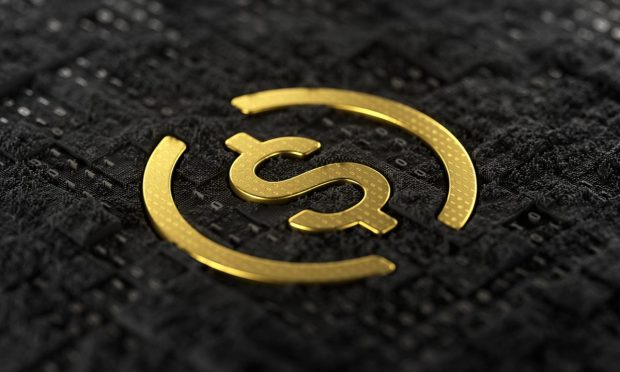In Winning DeFi, Circle’s USDC Shows It Can Be the No. 1 Stablecoin

Circle’s USD Coin (USDC) is winning the stablecoin war.
On Ethereum, at any rate.
While USDC is still solidly the No. 2 stablecoin by market capitalization, with $45.4 billion in circulation, by that measure it remains far behind the leader, Tether’s USDT, with $78.4 billion extant.
Stablecoins are a type of cryptocurrency that maintain a one-to-one peg with the U.S. dollar — or other national currencies — by holding a one-to-one cache of assets like dollars, T-bills and other (theoretically) highly liquid investments.
On Ethereum, however, USDC overtook USDT late last week, with blockchain information tool Etherscan showing 39.92 billion USDC, while USDT had a total supply of 39.82 billion.
Read also: What is Staking?
So what? Well, the vast majority of decentralized finance (DeFi) lives on Ethereum, and stablecoins play a big role in DeFi. One of DeFi’s largest use cases, decentralized lending platforms, accept collateral in a variety of cryptocurrencies from borrowers, but they make loans in stablecoins. While these stablecoins can be used for anything, most are used in staking, yield farming and liquidity mining — all ways of earning passive interest of crypto holdings.
See more: What is Yield Farming and Liquidity Mining?
That’s probably why USDC is growing so much faster.
USDC started 2021 with a $4.10 billion market cap and started 2022 with a $42.56 billion market cap — a growth rate of more than 10 times.
Leader Tether, which launched in 2015 — three years before USDC — started 2021 at $21.34 billion and hit $78.37 billion this past New Year’s Day — a growth rate of about 3.7 times.
DeFi grew into a serious crypto finance industry last year, growing from a $28 billion industry at the beginning of 2021 to one in which $96 billion is currently invested — and it had cracked $100 billion before the recent crypto bear market.
The first, and still the biggest, use of stablecoins is in trading cryptocurrencies. Many frequent traders keep funds in stablecoins, in large part because its far easier to buy most cryptocurrencies for stablecoins rather than in “atomic swaps” in which one cryptocurrency is traded directly for another — selling bitcoin directly for ether, for example. With smaller cryptocurrencies, those trading pairs can be hard to find.
Trust Matters
ConsenSys, a leading Ethereum development company, argued in a March blog post that difference was trust.
“One of the central reasons is that the market trusts Circle and Coinbase to issue USDC appropriately,” it said. “The market views Coinbase and Circle as incredibly conservative companies who closely adhere to the law.”
Tether, in contrast, has had some trust issues. It was fined $18 million to settle a lawsuit by New York’s Attorney General after it was discovered that the funds and investments backing USDT had dropped to 74%. Tether only released a breakdown of the makeup of its backing funds last May — as part of the settlement — and was then discovered to have just 2.9% of its backing funds in cash. Fully 65% was in the form of commercial paper — unsecured, short-term, corporate debt.
Read also: US Treasury Eyes Probe of Stablecoins’ Financial Risk
Circle’s USDC — issued in partnership with public crypto exchange Coinbase — is 100% cash and U.S. treasuries, although there was an outcry when it was found to have a bit more than 72% in cash and treasuries, with the rest in other investments, including 9% in commercial paper.
See more: Circle’s New Reserve Details Show Reservations Over Stablecoin Reserves
However, Circle quickly announced a new policy of putting all of its backing funds in dollars and treasuries. And, its backing funds have been audited by a major accounting firm, Grant Thornton — something Tether cannot say.
Circle CEO Jeremy Allaire has been a vocal supporter of substantial regulation of stablecoins, including the Nov. 1 President’s Working Group on Financial Markets report’s call to require stablecoin issuers be federally chartered and insured depository institutions.
Allaire said doing so would protect customers and put stablecoins “on a level playing field with other providers of similar services, such as banks.”
Read also: Powell, Yellen Clash Over Stablecoin Regulation at Senate Hearing
He has also made clear that Circle intends to get a federal bank charter.
See more: USDC Creator Circle Seeks Full-Reserve National Commercial Bank Status
In March, Visa announced that it will settle transactions across its 70-million-strong merchant network in USDC.
Read more: Visa Network Will Settle Transactions In Crypto, First Use Case USD Stablecoin
USDC’s advantage — it’s market cap is triple the No. 3 stablecoin, Binance USD — may be facing a challenge soon. Another, smaller but also well-regulated stablecoin issuer, Paxos, with a $4 billion market cap, just announced a very big partnership.
See more: Is Paxos the New Diem?
The adoption of Paxos by WhatsApp, the Facebook-owned messaging service with 2 billion users, means the No. 7 stablecoin is suddenly coming up strong on the outside.
Paxos was adopted by Facebook’s Novi digital wallet, which it developed for the highly controversial (and still alive) Diem stablecoin project — formerly Libra, which got politicians, central bankers and international financial organization up in arms about the potential of stablecoins to undercut national currencies and weaken countries’ ability to counteract financial downturns and crises.
